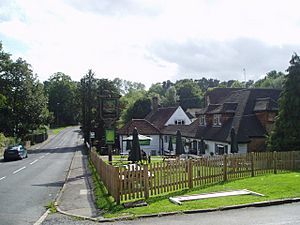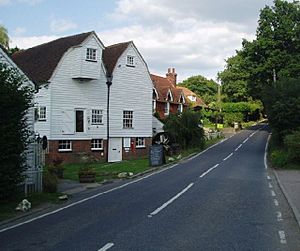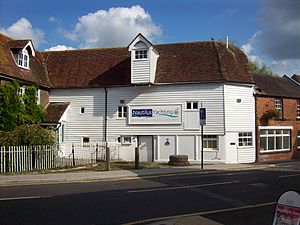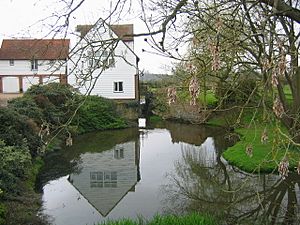Medway watermills (upper tributaries) facts for kids
The River Medway and its smaller rivers (called tributaries) have been used for power for over 1,150 years! More than 200 places along these rivers are known to have used water power.
People used this power for many things. They ground corn into flour, made paper, processed cloth (called fulling), melted iron (smelting), pumped water, made gunpowder, extracted oil from vegetables, and even generated electricity.
Today, only one watermill still works for trade. Many old mills have been changed into other things. You might find them as homes, restaurants, museums, or even places for weddings! Some are just old, broken buildings, or only their lower walls remain. Most have disappeared completely.
Many smaller rivers flow into the River Medway. This article will tell you about the watermills on these rivers, starting from where they begin and moving downstream. We'll look at the rivers that join the Medway above a place called Penshurst.
Contents
- West Hoathly Stream: Old Foundries
- East Grinstead Stream: Mills and Pubs
- Hartfield Stream: Iron and Film Locations
- Warren Brook: Mills and Pumps
- Mill Brook or Steel River: Ironworks and Cannons
- Waterdown Forest Stream: More Mills and Forges
- The Jarvis Brook: Furnaces and Forges
- Eridge Stream: Large Ponds and Iron Works
- Motts Mill Stream: Old Records
- Groombridge Stream: A Mill by a Lake
- Kent Water: Many Mills and a Museum
- Gibbs Brook: Gunpowder and Leather
- Eden Brook: Old Hammer Mills
- Crooked River: A Mill Site
- Felbridge Water: Hammer Mills
- Other Eden Tributaries: More Mills
- Images for kids
West Hoathly Stream: Old Foundries
A small stream starts at West Hoathly. It flows into the Medway from the right side, just before Mill Place Mill.
Gravetye Foundry: Gun Making
There was once a place here called Gravetye, where people made guns. The pond that powered it is still there today.
East Grinstead Stream: Mills and Pubs
This stream flows through East Grinstead. It joins the Medway from the left side, just before Brambletye Mill.
Brook Mill: Manor's Mill
This mill belonged to the Imberhorne Manor, serving the local estate.
Dunnings Mill: A Pub with a Wheel
Dunnings Mill was a mill for grinding corn. Records show it existed in 1713, but it might be even older. The mill was taken down in the early 1900s. In 1932, a special gate (called a sluice gate) marked its spot. Now, a pub stands there, and it even has a modern waterwheel!
Hartfield Stream: Iron and Film Locations
A stream flows through Hartfield and enters the Medway from the left. It powered four watermills.
Bower Forge: Iron Works
This forge, where iron was shaped, might have been around in 1558. It was working in 1653 but was ruined by 1664. The dam that held back the water was about 200 meters long. A large house nearby, Hammerwood, got its name from this forge.
Cansiron Furnace, Hartfield: Old Iron Production
This was a furnace and forge mentioned in 1563. It was used from 1574 to 1700. Many different owners and ironmasters ran it over the years. Even though it was ruined by 1664, it seems it was repaired and used again in 1700.
Bolebroke Mill, Hartfield: A Historic Hotel
This mill was mentioned in the Domesday Book, a very old survey from 1086! The building you see today was built in 1740. It was a corn mill with a large waterwheel. The Atherfold family were millers here for a very long time, from 1602 until the mid-1880s. The waterwheel was damaged in a storm in 1977 and taken apart, but much of the inside machinery is still there. The mill is now a small hotel and was even in the 1995 film Carrington!
Warren Brook: Mills and Pumps
The Warren Brook starts near Crowborough Beacon. It flows into the Medway from the right side, after the Hartfield Stream. It powered six watermills.
Crowborough Furnace: Iron and Corn
This furnace was recorded in 1593. The dam was about 120 meters long and up to 3 meters high. Later, a corn mill called Woodeaves Mill stood on the site of this old furnace.
Withyham Mill: Sketched by Turner
This was a corn mill. Many different millers worked here over the centuries. The famous artist J. M. W. Turner even sketched this mill around 1795!
Water Powered Pump, Withyham: Old Technology
Around 1900, a water-powered pump was built at the site of Withyham mill. It used an 8-foot waterwheel to power a pump. The old pump house is still there, but it's no longer used.
Mill Brook or Steel River: Ironworks and Cannons
The Mill Brook starts in Ashdown Forest. It joins the Warren Brook from the left side, just before the Warren Brook flows into the Medway. This brook powered seven watermills.
Steel Forge, Hartfield: Early Iron Works
This was an ironworks built around 1505. It was used by various people and stopped working for a while, but then started up again.
Pippingford Furnace, Hartfield: Cannons Found Here
Pippingford Furnace was one of the first blast furnaces built in the area, very close to Steel Forge. The dam was about 125 meters long. This furnace was built between 1693 and 1696. In 1970, a cannon was dug up here!
Newbridge Furnace: The First Blast Furnace
This was the very first blast furnace built in the area, working in 1497! It was last known to be working in 1574. The dam was about 180 meters long.
Newbridge Mill, Coleman's Hatch: A Home with a Wheel
In 1598, this mill was recorded as having two watermills under one roof. The building that stands today was built in 1830 and is now a home. It still has its overshot waterwheel, which is made of cast iron and is 10 feet in diameter.
Waterdown Forest Stream: More Mills and Forges
This stream starts near Jarvis Brook and flows into the Medway from the right. It powered three watermills, and its own smaller streams also powered mills.
Cowford Furnace: Built in 1562
This furnace was built in 1562. It seems to have stopped working by 1574. The dam was about 70 meters long.
Redgate Mill, Rotherfield: Corn Mill Site
Redgate Mill was a corn mill, built on the site of an even older furnace.
Birchden Forge, Rotherfield: A Busy Forge
Birchden Forge had a large pond fed by two streams. It was mentioned in a will from 1524 and was bought and sold by many important families over the years. It was still working in 1667. A boring mill (for making holes in things) was built here in 1677. The forge was still mentioned in sales as late as 1719. The dam was about 155 meters long.
The Jarvis Brook: Furnaces and Forges
This stream starts near Rotherfield and joins the Waterdown Forest Stream. It powered a furnace.
Maynards Gate Furnace: Iron Production
This was an iron furnace, possibly also known as Knights Place. It was likely working in 1562 and was owned by Lord Buckhurst in 1574. It was working in 1653 but was ruined by 1664.
Eridge Stream: Large Ponds and Iron Works
A stream starts in Eridge and flows into the Waterdown Forest Stream.
Eridge Furnace: A Big Pond
A large pond in Eridge Park shows where Eridge Furnace used to be. It was owned by Lord Abergavenny in 1574 and was working in 1603. The dam was very long, about 210 meters, and up to 7.5 meters high!
Eridge Forge: Below the Furnace
This forge was located just below Eridge Furnace. It was also owned by Lord Abergavenny in 1574. In 1717, this forge produced 30 tons of iron.
Motts Mill Stream: Old Records
A stream starts near Withyham and powered a watermill.
Motts Mill, Withyham: Many Names
Motts Mill was recorded on maps in 1597 as Shurlock's Water Mill and in 1598 as Motts Mill. It was also called Moat Mill Common on a 1797 map. The area was still known as Motts Mill in the 1838 census.
Groombridge Stream: A Mill by a Lake
This stream starts south of Tunbridge Wells and flows west, joining the Medway from the right. It powered two watermills.
Groombridge Mill: Working Until the 1930s
Groombridge Mill was used until about 1934. It was fed by the lake at Groombridge Place. It had a large overshot waterwheel that drove three pairs of millstones.
Kent Water: Many Mills and a Museum
A stream starts above Cowden and flows into the Medway from the left. It powered eight watermills.
Scarletts Furnace, Cowden: Storm Damage
Scarletts Furnace was built in 1547. It was badly damaged in a storm in 1703 and stopped working by 1717.
Scarletts Mill, Cowden: Demolished by Floods
A mill here belonged to Richard Saxpes in 1516. A corn mill was owned by the Knight family in 1768. It was working in 1932 but was badly damaged by floods in 1937 and then taken down.
Cowden Furnace: A King's Signer
A furnace was working here in 1556. It was owned by the Titchbourne family. Robert Titchbourne was one of the 59 men who signed a document related to King Charles I. The furnace was in ruins by 1664, and the site was later used for a corn mill. A spoiled cannon casting, called the Cowden Gun, was dug up here.
Cowden Mill: Converted to a Home
A corn mill was here in 1786 and closed before World War I. It has now been changed into a home.
Haxted Mill, Edenbridge: A Museum and Restaurant
Haxted Watermill is in Surrey, very close to Kent. It's another Domesday site, mentioned in 1361. The western part of the building is from about 1580, and the eastern part is from 1794. The mill last ground flour in 1919 but worked until 1945. It became a museum in 1969 but is now a restaurant and bar.
The current waterwheel was put in around 1830. It's an overshot wheel, meaning water flows over the top to turn it. It's 10 feet wide and 9 feet in diameter. In 1972, its iron buckets were replaced with fiberglass ones. This wheel produced about 11 horsepower and drove three pairs of millstones.
Town Mill, Edenbridge: Draining Marshland
In 1291, a water-powered pump was used here to drain marshland between Lingfield and Edenbridge. The current corn mill building is from the early 1800s. It had a cast iron waterwheel that drove three pairs of stones. The mill last ground by water before World War I.
Chiddingstone Mill: Now a House
This might also be a Domesday site. The millers in the 1700s were the Keeys family. The mill was last used in the 1930s. For many years, it was just an empty shell, but the building has now been turned into a house. No machinery remains inside.
Gibbs Brook: Gunpowder and Leather
The Gibbs Brook, also known as the Gippes River, powered four watermills.
Ivy Mill, Godstone: Burnt Down
This mill belonged to the manor of Chevington. It was partly rebuilt in 1698. Sadly, it burned down in the 1920s.
Leigh Mill, Godstone: Gunpowder Production
This Domesday mill was worth nothing in 1349 because all the tenants died in the plague. Later, in Elizabethan times, it became a gunpowder mill! It was owned by George Evelyn, the grandfather of the famous diarist John Evelyn. His mills at Godstone were very important for making gunpowder in the country. The mill has been turned into a home, and only the axle and pit wheel of the machinery are left.
Eden Brook: Old Hammer Mills
The Eden Brook powered three watermills.
Hedgecourt Mill, Felbridge: A Long History
This was an old hammer mill site. It was first mentioned in 1562. In 1567, the mill was described as "newly erected" with an overshot waterwheel. It was a corn mill, and later, in 1745, it became a furnace mill. The mill was still working in 1910. By 1948, it was a ruin, but the machinery was still there. The upper floors were taken down in 1949, and the lower part was used for storing boats. In 1969, the building was converted into two homes.
The machinery included a large overshot waterwheel, 12.5 feet in diameter, made of cast iron and wood. This wheel drove a large cast iron pit wheel, which in turn powered two pairs of millstones.
Felcourt Mill, Felbridge: From Iron to Pub
This was another old hammer mill site, working from 1567 to 1786. It was also known as a drawing mill, which means it pulled wire. The pond at Hedgecourt Mill helped store water for this forge. It used an overshot waterwheel to power a tilt hammer and another waterwheel for bellows (to blow air into the furnace).
In 1800, it became known as Wire Mill. It was converted to a corn mill around 1816. By 1851, it had two overshot waterwheels and drove four pairs of millstones. The mill lake covered 14 acres! It was sold several times and eventually became the Wire Mill Tea Gardens, then a fishing club, and now it's a pub. The building no longer has its machinery.
Lingfield Tannery: Water-Powered Leather
This tannery, where leather was made, was powered by water. It was located across from the current Lingfield Racecourse. The tannery building was rebuilt around 1840. In 1996, it was demolished, and now a small housing development stands on the site.
Crooked River: A Mill Site
This river starts from springs south of the Greensand Ridge. It joins the Kent Brook.
Doghurst Mill: Site of a Former Mill
This mill was located at Itchingwood Common. On an 1868 map, the building was still standing, but it was marked as the "site of former water mill," and the mill pond was dry.
Felbridge Water: Hammer Mills
The Felbridge Water is a smaller river that flows into the Eden Brook. It powered two watermills.
Clarkes Mill, Lingfield: Lady Gage's Mill
This was a hammer mill, owned by Lady Gage in 1574.
Ware Mill, Felbridge: An Ancient Site
A mill was on this site as early as 1241! It was granted to John Gainsford in 1347.
Other Eden Tributaries: More Mills
Other smaller rivers flowing into the River Eden also powered watermills.
Four Elms Mill, Hever: A Tragic Accident
This might be the Hever mill mentioned in 1279. Sadly, a boy named Roland was dragged into the cogs and crushed to death while trying to "twirl the wheel." The mill had an overshot wheel and was demolished by 1933.
Bough Beech Furnaces, Hever: Two Furnaces
This was an old hammer mill site, and two furnaces are known to have existed here.
Christmas Mill, Edenbridge: A Double Mill
This was a "double mill" in 1347, meaning it had two waterwheels. The mill building is still standing today, converted into a home.
Salman's Farm Mill, Penshurst: A Domesday Corn Mill
This is another Domesday site. This corn mill was powered by a pond fed by a stream. It had a cast iron overshot waterwheel. The machinery was removed in the early 1930s, but the cast iron axle is still there.
Images for kids













